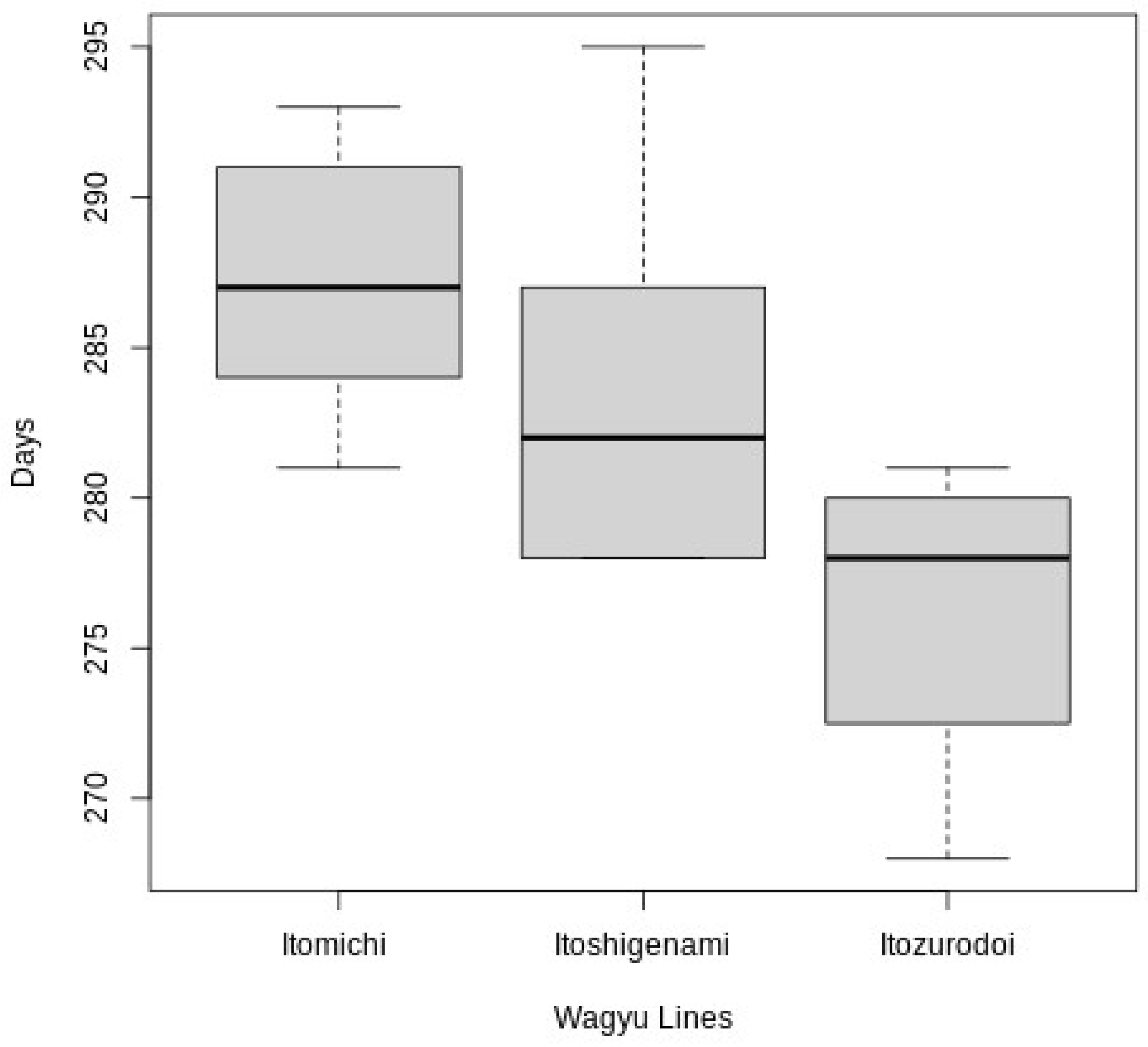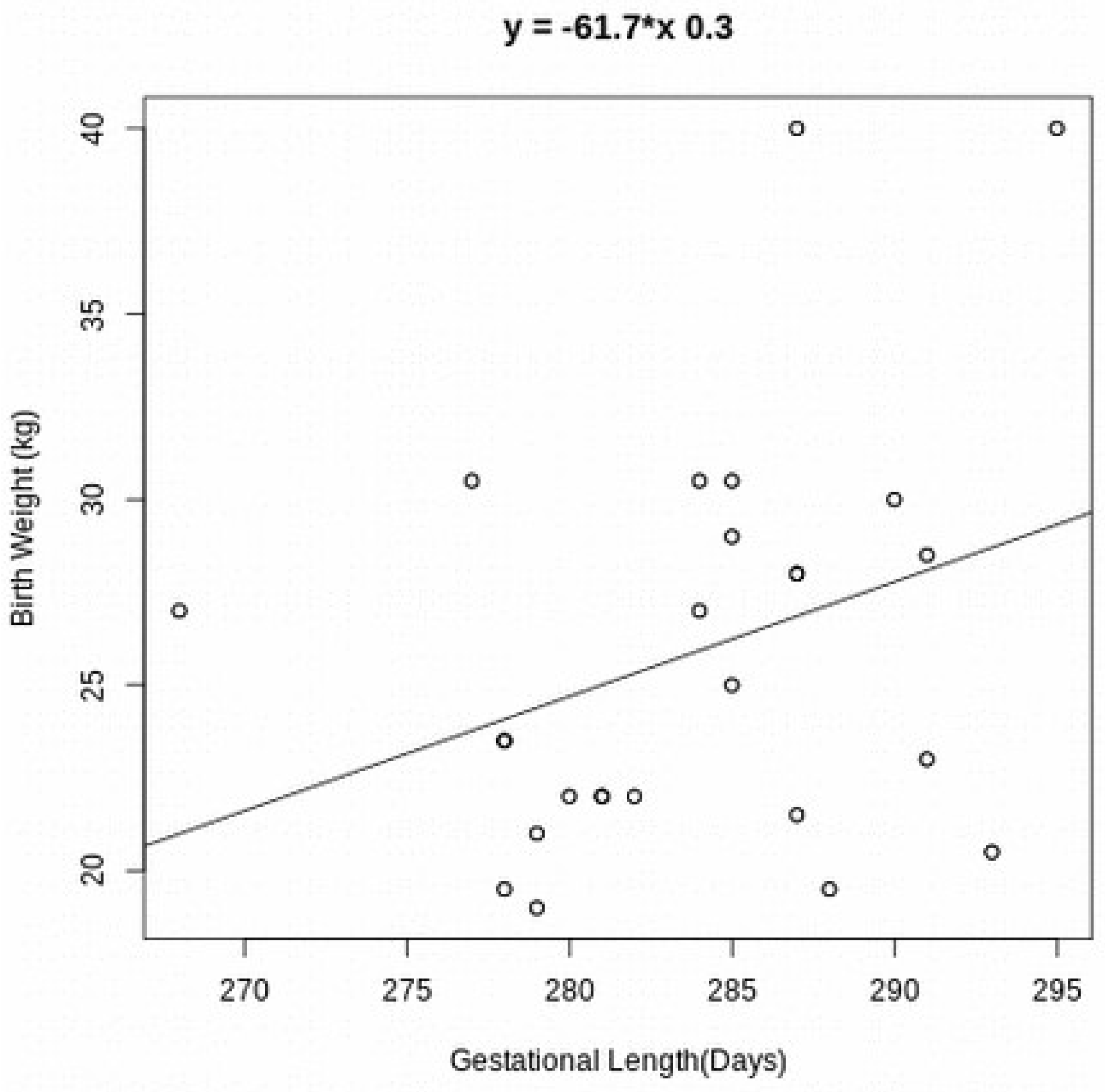The Sire Effect on Gestational Length in Wagyu Cattle
Simple Summary
Abstract
1. Introduction
2. Material and Methods
Experimental Design
3. Results
4. Discussion
Author Contributions
Funding
Institutional Review Board Statement
Informed Consent Statement
Data Availability Statement
Conflicts of Interest
References
- Diskin, M.G.; Kenny, D.A. Managing the Reproductive Performance of Beef Cows. Theriogenology 2016, 86, 379–387. [Google Scholar] [CrossRef] [PubMed]
- Silva, H.M.; Wilcox, C.J.; Thatcher, W.W.; Becker, R.B.; Morse, D. Factors Affecting Days Open, Gestation Length, and Calving Interval in Florida Dairy Cattle. J. Dairy. Sci. 1992, 75, 288–293. [Google Scholar] [CrossRef] [PubMed]
- Andersen, H.; Plum, M. Gestation Length and Birth Weight in Cattle and Buffaloes: A Review. J. Dairy Sci. 1965, 48, 1224–1235. [Google Scholar] [CrossRef] [PubMed]
- Nogalski, Z.; Piwczyński, D. Association of Length of Pregnancy with Other Reproductive Traits in Dairy Cattle. Asian-Australas. J. Anim. Sci. 2012, 25, 22. [Google Scholar] [CrossRef]
- Vieira-Neto, A.; Galvão, K.N.; Thatcher, W.W.; Santos, J.E.P. Association among Gestation Length and Health, Production, and Reproduction in Holstein Cows and Implications for Their Offspring. J. Dairy Sci. 2017, 100, 3166–3181. [Google Scholar] [CrossRef] [PubMed]
- Hansen, M.; Lund, M.S.; Pedersen, J.; Christensen, L.G. Gestation Length in Danish Holsteins Has Weak Genetic Associations with Stillbirth, Calving Difficulty, and Calf Size. Livest. Prod. Sci. 2004, 91, 23–33. [Google Scholar] [CrossRef]
- Pajohande, K.; Amirabadi Farahani, T.; Farsuni, N.E. Increased Incidence of Reproductive Disorders Associated with Short Gestation Length in Holstein Dairy Cows. Theriogenology 2023, 205, 9–17. [Google Scholar] [CrossRef]
- Motoyama, M.; Sasaki, K.; Watanabe, A. Wagyu and the Factors Contributing to Its Beef Quality: A Japanese Industry Overview. Meat Sci. 2016, 120, 10–18. [Google Scholar] [CrossRef]
- Gotoh, T.; Joo, S.T. Characteristics and Health Benefit of Highly Marbled Wagyu and Hanwoo Beef. Korean J. Food Sci. Anim. Resour. 2016, 36, 709. [Google Scholar] [CrossRef]
- Scraggs, E.; Zanella, R.; Wojtowicz, A.; Taylor, J.F.; Gaskins, C.T.; Reeves, J.J.; de Avila, J.M.; Neibergs, H.L. Estimation of Inbreeding and Effective Population Size of Full-Blood Wagyu Cattle Registered with the American Wagyu Cattle Association. J. Anim. Breed. Genet. 2014, 131, 3–10. [Google Scholar] [CrossRef]
- de Marchi, F.; Lazzaretti, R.; de Camargo, J.; Facioli, F.L.; Zanella, E.L.; Nacib Jorge-Neto, P.; Groke Marques, M.; Caires, K.C.; Zanella, R. Association between Anti-Müllerian Hormone Levels and Reproductive Parameters in Wagyu Cattle Raised in Brazil. Zygote 2023, 31, 366–372. [Google Scholar] [CrossRef]
- Facioli, F.L.; Marchi, F.D.; Marques, M.G.; Michelon, P.R.P.; Zanella, E.L.; Caires, K.C.; Reeves, J.J.; Zanella, R. The Outcome and Economic Viability of Embryo Production Using IVF and SOV Techniques in the Wagyu Breed of Cattle. Vet. Sci. 2020, 7, 58. [Google Scholar] [CrossRef] [PubMed]
- Moura, A.R.; Santos, A.R.; Losano, J.D.A.; Siqueira, A.F.P.; Hamilton, T.R.S.; Zanella, R.; Caires, K.C.; Simões, R. Evaluation of Sperm and Hormonal Assessments in Wagyu, Nellore, and Angus Bulls. Zygote 2023, 31, 507–516. [Google Scholar] [CrossRef] [PubMed]
- Pekkala, N.; Knott, K.E.; Kotiaho, J.S.; Puurtinen, M. Inbreeding Rate Modifies the Dynamics of Genetic Load in Small Populations. Ecol. Evol. 2012, 2, 1791–1804. [Google Scholar] [CrossRef] [PubMed]
- Pekkala, N.; Knott, K.E.; Kotiaho, J.S.; Nissinen, K.; Puurtinen, M. The Effect of Inbreeding Rate on Fitness, Inbreeding Depression and Heterosis over a Range of Inbreeding Coefficients. Evol. Appl. 2014, 7, 1107–1119. [Google Scholar] [CrossRef] [PubMed]
- Dowling, D.F. Effect of Birth Weight on Efficiency of Beef Production. Aust. Vet. J. 1979, 55, 167–169. [Google Scholar] [CrossRef]
- Greenwood, P.L.; Cafe, L.M. Prenatal and Pre-Weaning Growth and Nutrition of Cattle: Long-Term Consequences for Beef Production. Animal 2007, 1, 1283–1296. [Google Scholar] [CrossRef]
- Vaz, R.Z.; Lobato, J.F.P.; Restle, J.; Costa, P.T.; Eloy, L.; Costa, J.L.B. Weight at Conception and Gestational Gains in the Efficiency of Beef Cows and Progeny Performance. Acad. Bras. Cienc. 2022, 94, e20191280. [Google Scholar] [CrossRef]
- Duarte, M.S.; Paulino, P.V.R.; Nascimento, C.S.; Botelho, M.E.; Martins, T.S.; Filho, S.C.V.; Guimarães, S.E.F.; Serão, N.V.L.; Dodson, M.V.; Du, M.; et al. Maternal Overnutrition Enhances MRNA Expression of Adipogenic Markers and Collagen Deposition in Skeletal Muscle of Beef Cattle Fetuses. J. Anim. Sci. 2014, 92, 3846–3854. [Google Scholar] [CrossRef]
- Wilson, T.B.; Long, N.M.; Faulkner, D.B.; Shike, D.W. Influence of Excessive Dietary Protein Intake during Late Gestation on Drylot Beef Cow Performance and Progeny Growth, Carcass Characteristics, and Plasma Glucose and Insulin Concentrations. J. Anim. Sci. 2016, 94, 2035–2046. [Google Scholar] [CrossRef]
- Zago, D.; Canozzi, M.E.A.; Barcellos, J.O.J. Pregnant Cow Nutrition and Its Effects on Foetal Weight—A Meta-Analysis. J. Agric. Sci. 2019, 157, 83–95. [Google Scholar] [CrossRef]
- Mossa, F.; Carter, F.; Walsh, S.W.; Kenny, D.A.; Smith, G.W.; Ireland, J.L.H.; Hildebrandt, T.B.; Lonergan, P.; Ireland, J.J.; Evans, A.C.O. Maternal Undernutrition in Cows Impairs Ovarian and Cardiovascular Systems in Their Offspring. Biol. Reprod. 2013, 88, 92. [Google Scholar] [CrossRef] [PubMed]
- Park, S.J.; Beak, S.H.; Jung, D.J.S.; Kim, S.Y.; Jeong, I.H.; Piao, M.Y.; Kang, H.J.; Fassah, D.M.; Na, S.W.; Yoo, S.P.; et al. Genetic, Management, and Nutritional Factors Affecting Intramuscular Fat Deposition in Beef Cattle—A Review. Asian-Australas. J. Anim. Sci. 2018, 31, 1043–1061. [Google Scholar] [CrossRef]
- Du, M.; Wang, B.; Fu, X.; Yang, Q.; Zhu, M.J. Fetal Programming in Meat Production. Meat Sci. 2015, 109, 40–47. [Google Scholar] [CrossRef] [PubMed]
- Ferrell, C. Factors Influencing Fetal Growth and Birth Weight in Cattle. Beef Res. Program. Prog. Rep. 1993, 4, 104–107. Available online: https://digitalcommons.unl.edu/hruskareports/132 (accessed on 22 July 2024).
- Heinrichs, A.J.; Heinrichs, B.S.; Harel, O.; Rogers, G.W.; Place, N.T. A Prospective Study of Calf Factors Affecting Age, Body Size, and Body Condition Score at First Calving of Holstein Dairy Heifers. J. Dairy. Sci. 2005, 88, 2828–2835. [Google Scholar] [CrossRef]
- Swali, A.; Wathes, D.C. Influence of the Dam and Sire on Size at Birth and Subsequent Growth, Milk Production and Fertility in Dairy Heifers. Theriogenology 2006, 66, 1173–1184. [Google Scholar] [CrossRef]
- Coleman, L.; Back, P.; Blair, H.; López-Villalobos, N.; Hickson, R. Sire Effects on Birth Weight, Gestation Length, and Pre-Weaning Growth of Beef-Cross-Dairy Calves: A Case Study in New Zealand. Dairy. 2021, 2, 385–395. [Google Scholar] [CrossRef]
- Rezende, E.V.; Reis, I.J.; Campos, C.C.; Santos, R.M. Influence of Gestation Length, Seasonality, and Calf Sex on Birth Weight and Placental Retention in Crossbred Dairy Cows. Ciênc. Anim. Bras. 2020, 21, e-52881. [Google Scholar] [CrossRef]
- Jaborek, J.R.; Fluharty, F.L.; Zerby, H.N.; Relling, A.E. Growth Performance, Carcass Characteristics, and Fatty Acid Composition of Angus- and Wagyu-Sired Finishing Cattle Fed for a Similar Days on Feed or Body Weight Endpoint. J. Anim. Sci. 2023, 101, skac343. [Google Scholar] [CrossRef]
- Lloyd, S.S.; Valenzuela, J.L.; Steele, E.J.; Dawkins, R.L. Genetics of Marbling in Wagyu Revealed by the Melting Temperature of Intramuscular and Subcutaneous Lipids. Int. J. Food Sci. 2017, 2017, 3948408. [Google Scholar] [CrossRef]




| Bull Line | Number of Calves | Gestational Length (GL) | Weight (kg) |
|---|---|---|---|
| Itoshigenami | 22 | 283 ± 5.44 A | 26.8 ± 7.34 |
| Itozurodoi | 8 | 276 ± 5.74 B | 25.1 ± 4.44 |
| Itomichi | 22 | 287 ± 3.74 C | 25.3± 4.20 |
Disclaimer/Publisher’s Note: The statements, opinions and data contained in all publications are solely those of the individual author(s) and contributor(s) and not of MDPI and/or the editor(s). MDPI and/or the editor(s) disclaim responsibility for any injury to people or property resulting from any ideas, methods, instructions or products referred to in the content. |
© 2024 by the authors. Licensee MDPI, Basel, Switzerland. This article is an open access article distributed under the terms and conditions of the Creative Commons Attribution (CC BY) license (https://creativecommons.org/licenses/by/4.0/).
Share and Cite
de Camargo, J.; Alba, C.; Gallas, C.; Kronbauer, T.V.; Mozzato, M.T.; Delazeri, D.P.; Marques, M.G.; Zanella, E.L.; Zanella, R. The Sire Effect on Gestational Length in Wagyu Cattle. Vet. Sci. 2024, 11, 551. https://doi.org/10.3390/vetsci11110551
de Camargo J, Alba C, Gallas C, Kronbauer TV, Mozzato MT, Delazeri DP, Marques MG, Zanella EL, Zanella R. The Sire Effect on Gestational Length in Wagyu Cattle. Veterinary Sciences. 2024; 11(11):551. https://doi.org/10.3390/vetsci11110551
Chicago/Turabian Stylede Camargo, Janine, Carla Alba, Caroline Gallas, Thales Vogt Kronbauer, Mateus Timbola Mozzato, Dominike Prediger Delazeri, Mariana Groke Marques, Eraldo Lourenso Zanella, and Ricardo Zanella. 2024. "The Sire Effect on Gestational Length in Wagyu Cattle" Veterinary Sciences 11, no. 11: 551. https://doi.org/10.3390/vetsci11110551
APA Stylede Camargo, J., Alba, C., Gallas, C., Kronbauer, T. V., Mozzato, M. T., Delazeri, D. P., Marques, M. G., Zanella, E. L., & Zanella, R. (2024). The Sire Effect on Gestational Length in Wagyu Cattle. Veterinary Sciences, 11(11), 551. https://doi.org/10.3390/vetsci11110551






